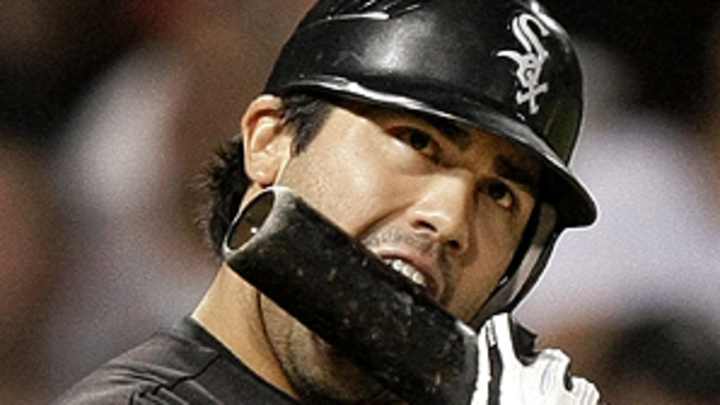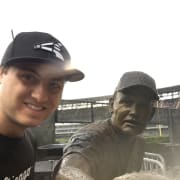Injury-Shortened Sox Seasons: Carlos Quentin's short temper costs him an MVP

On Sept. 1, 2008, Carlos Quentin's wooden bat splintered as he chopped a ground ball into a game-ending double play at Progressive Field in Cleveland.
The Chicago White Sox lost the game. Carlos Quentin lost his season.
A couple of pitches before that ball sputtered across the infield, Quentin had given himself his own demerit – a self-induced slap on the wrist when he fouled off a pitch he clearly deemed more hittable than the one he'd eventually send dribbling to second base.
It's something Quentin later lamented he'd done thousands of times before throughout all levels of his playing days, a seemingly harmless tap of his clenched right fist on the head of a bat held firmly in his left hand.
But on that night in Cleveland – the White Sox tied with the Minnesota Twins atop the AL Central, both with 77-60 records – the glossy wooden barrel hit the sweet spot of Quentin's right forearm.
He didn't know it until after the game, but that quick-twitch decision shattered a bone and ended a career year. With his wrist wrapped up just a week later after corrective surgery, so too was Quentin's torrid MVP-pace.
Quentin had been slashing .288/.394/.571 at the time, with an American League-leading 36 home runs to go along with 26 doubles, 100 RBIs, and 60 walks to 88 strikeouts despite his massive power.
Already an All-Star that season, Quentin was well on his way to building an MVP resume.
Not only that, but sans injury, the White Sox may have surged past the Twins during September and avoided the famed Blackout Game altogether. In fact, with the prolific right-handed slugger in the lineup, the script during the playoffs could have gone differently as well.
Who knows if a healthy Quentin could have truly put the White Sox on a championship trajectory, but there's certainly a non-zero possibility he could have made a sizable difference.
It's notable to revisit how Quentin even donned Chicago black and white in the 2008 season, because it was largely a different injury that led to him being in the Windy City in the first place.
Quentin was shipped to Chicago from the desert in the 2007 offseason, when then-general manager Ken Williams acquired him from the Arizona Diamondbacks in exchange for White Sox first base prospect Chris Carter, who was the organization's fourth-best farmhand at the time, per Baseball Prospectus.
Quentin was an odd man out in Arizona, and while a promising young bat, he'd been hampered by shoulder and hamstring injuries the prior season. He'd even receive offseason surgery on a torn labrum before arriving to camp with Chicago.
Quentin's entire career was underpinned by an injury narrative. He was drafted 29th overall by Arizona in 2003 after being a polished college bat at Stanford for three years. But he could have even gone a few slots higher, had he not been slated to be sidelined to start his pro career due to Tommy John surgery.
He was healthy in Arizona's minor league system before showing promise over a 57-game cup of coffee as a 23-year-old in 2006 – sporting an .872 OPS with 13 doubles, three triples, and nine home runs.
Then came the injury-riddled 2007 and crowded Diamondbacks outfield, the trade to Chicago, and what looked like a colossal mistake by the Arizona front office.
Watching your forgotten man leading the league with 36 bombs for a first place team will do that to you – injure your ego and maybe your executive soul — but it was saved by Quentin's own predisposition to catching the injury bug.
While there was buzz Quentin had a shot to play in the ALCS, with the surgery reinforcing his wrist and designed to at least enable a quick bounce-back, Chicago was ousted by the Tampa Bay Rays in the divisional round to render the possibility moot.
Wrist injuries tend to sap power, which was an integral component to Quentin's game, but in 2009 that wouldn't prove to be the core detriment. This time, it was plantar fasciitis that put a foot on the neck of Quentin's follow-up campaign after he ultimately finished fifth in 2008 MVP voting.
Quentin had a .961 OPS in April 2009 before he played through pain in May, eventually hitting the DL at the end of that month. In full, he'd play just 99 games, finishing with 21 home runs but with just a .779 OPS.
Quentin bounced back in 2010 with 26 home runs and an .821 OPS, but his season was cut to just 131 games.
The 2011 season looked to be a resurgence of sorts, as Quentin was once again an All-Star and the now 28-year-old was hitting .254/.340/.499 with 24 home runs before injuring his shoulder on a diving catch attempt in the outfield in mid-August.
That injury would spell the end of his time in Chicago, as he was dealt with one year of control left to San Diego in a quasi-rebuilding trade for two pitchers who amounted to less than any continued digital ink on them is worth.
Quentin hit quite well for the Padres, with an .877 and .855 OPS in San Diego in 2012 and 2013 respectively, showing strong power, but once again with the qualifier of ailments.
A recurring knee injury caused Quentin to average just 84 games annually across both years. Despite that, he inked a three-year, $30 million extension with the Padres that was supposed to run through 2015.
The bottom totally fell out in 2014, though, when Quentin hit a hapless .177/.284/.315 over 50 games and had his pesky left knee flare up again.
Quentin retired at age 32 during the 2015 season after being acquired and released by the Atlanta Braves in a splash/salary dump hybrid when AJ Preller acquired closer Craig Kimbrel. Quentin immediately landed with the Seattle Mariners in their minor league system before publicly hanging up his cleats shortly thereafter.
He'd come out of retirement and attempt an Act Two with the Twins and Red Sox on minor league contracts in 2016 and 2017, but Quentin's career was effectively over.
With that quiet departure from the game, 2008 truly became symbolic of a career that could have been. Over a 162 game average, Quentin's power number output stabilized at exactly 34 doubles, 30 home runs, and 95 RBIs.
Mind you, some of that annualized projected value could even be suppressed by injury noise that affected his performance under the radar during periods in which he played through pain.
Post 2008, the White Sox would spend years looking to find outfield pop to pair with Paul Konerko and Jim Thome, and then later Adam Dunn, in the middle of the lineup. They tested out the likes of first Alex Rios, and eventually Dayan Viciedo.
But the reality is that such an elusive plug-and-play, 35 home-runs-a-year right-handed power bat could have just as easily been Carlos Quentin.
He could have been a permanent fixture in the middle of the order from age 25 into his 30s rather than a constant suture on the DL.
Using that tempered 162-game, 30-home run pace after 2008 and projecting seven more years with the club, with him essentially ending his tenure with Chicago in conjunction with Konerko at just age 32, would have given him 246 career home runs with Chicago – good for third overall in club history behind just Konerko and Thomas.
Subtract a full 30 home run season, and he'd still be just a nudge behind Harold Baines (221) and ahead of Carlton Fisk (214) for fourth overall in team history. Quentin would have been a memorable White Sox star, for sure, in that version of history.
Of course, so many different elements could have come into play, but from 2009-13 Chicago was generally attempting to contend and it's not hard to envision a heathy Quentin remaining in the fold.
Solid health on Quentin's part quite reasonably could have altered the reality of the 2009-13 White Sox seasons and aided Chicago in stamping another playoff appearance in the books.
It simply wasn't to be.
Quentin's career is an odd tale. It's the story of a polished college bat – a first-round pick, no less – living up to his promise with an MVP-caliber 2008 campaign and one that saw him put up above-average to All-Star numbers whenever he was in fact healthy.
Usually failed careers are marked by pure underperformance, or a combination of shortcomings on the field along with injury irrespective of that.
But for Quentin, injury was essentially the sole culprit here. For a guy who seemingly couldn't catch a break, he also caught plenty – just of the wrong nature.
Had the stars aligned differently, 2008 wouldn't have been an aberration but instead the beginning of a star-studded career.
Sometimes things just don't break right, or ironically they do but in a literal sense, and that's exactly what happened on Sept. 1, 2008, when a wooden barrel and bone collided just right — and a career broke off course.
